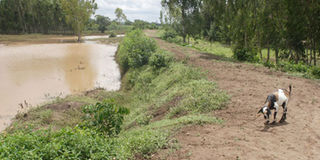Now floods menace is water under the bridge in Budalang’i

PHOTO | TOM OTIENO One of the dykes that have saved Budalang’i residents from perennial losses caused by floods in the region. This is the second year in a row that the five-metre-high dykes have prevented River Nzoia from bursting its banks.
What you need to know:
- Where rain water used to carry away crops, harvests have improved and schools no longer host families left homeless by the deluge
For many years, Budalang’i has been synonymous with floods. Not any more. The deluge that seemed to have defied all interventions has finally been tamed.
Farms that would have been swamped are now producing bumper harvests as schools that used to host the refugees displaced by floods have pupils running across their compounds on any given school day.
The water that for years was considered a menace has been tamed, thanks to a partnership between the government and the World Bank both of who pumped in millions of shillings to find a lasting solution to the floods that turned River Nzoia into a raging monster that had no respect for lives and property.
Goes about daily chores
Mr Rajab Owere, 55, whose home is barely 100 metres from River Nzoia, now goes about his daily chores with little worry despite the ongoing long rains in Budalang’i and other parts of the country. The father of 11 says there is unlikely to be flooding this year because the dykes were reinforced.
Since he moved to Bukhuba Village in Budalang’i, the rains and the accompanying floods would drive Mr Owere from his home every year as floods submerged parts of Busia and remote areas of Siaya counties.
“More often than not, at such a time of the year, we would be camping at a rescue centre somewhere in Nambale,” Mr Owere says.
The last time the area experienced flooding was in August 2011. Mr Owere lost his property and rice harvest to the raging waters. This year, however, he is upbeat after harvesting 50 bags of the cereal. He says the prevailing price of Sh3,000 per bag, though little, guarantees him good returns.
As floods cause havoc in other parts of the country, he and other families in Budalang’i are going about their daily tasks even with the meteorological services director Joseph Mukabana warning of prolonged rains.
Speaking to the Nation in a telephone interview, Mrs Lucy Mbuthia, an official with the National Water Conservation and Pipeline Corporation (NWCPC) said various strategies were used to win the battle against floods. Construction of two main dykes on Nzoia River, each measuring five metres high and 3.7 metres wide, and dyke realignment, have played a key role in taming the floods.
Another strategy was the use of a seepage control system that ensured no water gushed below the dykes back into the waterways to damage crops and settlement areas.
“We have just demonstrated to the whole world that anything is possible. No more cases of homes being marooned or people being evacuated,” said Mrs Mbuthia, the site agent at the River Nzoia dykes rehabilitation project.
According to Bunyala DC Khalif Abdi, each dyke has been built at a cost of Sh100 million.
The use of Bulala FM, a community radio station, has also helped win the war on floods by providing vital information as the station has been used to send out alerts.
Although farmers like Mr Owere are anxious due to past experiences, authorities are convinced that after surviving last year’s long rains and the short rains in January that caused flooding in other parts of the country, the floods have been tamed.
The dykes have been built 50 metres from the banks of River Nzoia, a strategy Ms Mbuthia says is meant prevent them from being weakened by high pressure.
“Such distances have enabled us to keep the dykes stronger as they are cushioned from the pressure of flowing water in the river channel,” she said.




